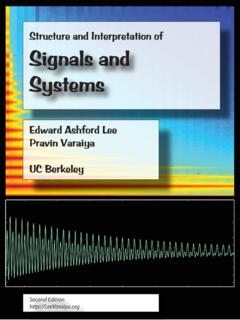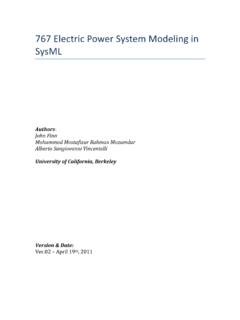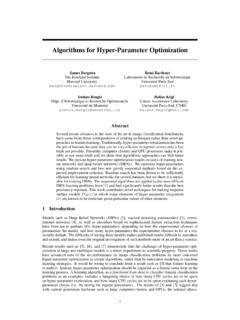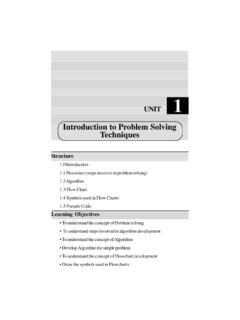Transcription of The Boolean Satisfiability Problem (SAT)
1 Fundamental Algorithms for System Modeling, Analysis, and OptimizationEdward A. Lee, Jaijeet Roychowdhury, Sanjit A. SeshiaUC BerkeleyEECS 144/244 Fall 2011 Copyright 2010-11, E. A. Lee, J. Roychowdhury, S. A. Seshia, All rights reservedBoolean Satisfiability (SAT) Solving2 The Boolean Satisfiability Problem (SAT) Given: A Boolean formula F(x1, x2, x3, .., xn) Can F evaluate to 1 (true)? Is F satisfiable? If yes, return values to xi s (satisfying assignment) that make F true 3 Why is SAT important? Theoretical importance: First NP-complete Problem (Cook, 1971) Many practical applications: Model Checking Automatic Test Pattern Generation Combinational Equivalence Checking Planning in AI Automated Theorem Proving Software Verification.
2 4An Example Inputs to SAT solvers are usually represented in CNF(a + b + c) (a + b + c) (a + b + c ) (a + b + c )5An Example Inputs to SAT solvers are usually represented in CNF(a+ b+ c) (a + b + c) (a+ b + c ) (a + b+ c )6 Why CNF?7 Why CNF? Input-related reason Can transform from circuit to CNF in linear time & space (HOW?) Solver-related: Most SAT solver variants can exploit CNF Easy to detect a conflict Easy to remember partial assignments that don t work (just add conflict clauses) Other ease of representation points? Any reasons why CNF might NOT be a good choice?8 Complexity of k-SAT A SAT Problem with input in CNF with at most k literals in each clause Complexity for non-trivial values of k: 2-SAT: in P 3-SAT: NP-complete > 3-SAT: ?
3 9 Worst-Case Complexity10 Beyond Worst-Case Complexity What we really care about is typical-case complexity But how can one measure typical-case ? Two approaches: Is your Problem a restricted form of 3-SAT? That might be polynomial-time solvable Experiment with (random) SAT instances and see how the solver run-time varies with formula parameters (#vars, #clauses, .. )11 Special Cases of 3-SAT that are polynomial-time solvable Obvious specialization: 2-SAT T. Larrabee observed that many clauses in ATPG tend to be 2-CNF Another useful class: Horn-SAT A clause is a Horn clause if at most one literal is positive If all clauses are Horn, then Problem is Horn-SAT Application:- Checking that one finite-state system refines (implements) another12 Phase Transitions in k-SAT Consider a fixed-length clause model k-SAT means that each clause contains exactly k literals Let SAT Problem comprise mclauses and nvariables Randomly generate the Problem for fixed k and varying m and n Question: How does the Problem hardness vary with m/n ?
4 133-SAT HardnessAs n increases hardness transition grows sharperm / n14 Transition at m/n' / n15 Threshold Conjecture For every k, there exists a c* such that For m/n < c*, as n , Problem is satisfiablewith probability 1 For m/n > c*, as n , Problem is unsatisfiable with probability 1 Conjecture proved true for k=2 and c*=1 For k=3, current status is that c* is in the range (2+p)-SAT Model We know: 2-SAT is in P 3-SAT is in NP Problems are (typically) a mix of binary and ternary clauses Let p {0,1} Let Problem comprise (1-p) fraction of binary clauses and p of ternary So-called (2+p)-SAT problem17 Experimentation with random (2+p)-SAT When p < ~ Problem behaves like 2-SAT Linear scaling When p > ~ Problem behaves like 3-SAT Exponential scaling Nice observations, but don t help us predict behavior of problems in practice18 Backbones and Backdoors Backbone [Parkes; Monasson et al.]
5 ] Subset of literals that must be true in every satisfying assignment (if one exists) Empirically related to hardness of problems Backdoor [Williams, Gomes, Selman] Subset of variables such that once you ve given those a suitable assignment (if one exists), the rest of the Problem is poly-time solvable Also empirically related to hardness But no easy way to find such backbones / backdoors! 19A Classification of SAT Algorithms Davis-Putnam (DP) Based on resolution Davis-Logemann-Loveland (DLL/DPLL) Search-based Basis for current most successful solvers Stalmarck s algorithm More of a breadth first search, proprietary algorithm Stochastic search Local search, hill climbing, etc.
6 Unable to prove unsatisfiability (incomplete)20 Resolution Two CNF clauses that contain a variable x in opposite phases (polarities) imply a new CNF clause that contains all literals except x and x (a + b) (a + c) = (a + b)(a + c)(b + c) Why is this true? 21 The Davis-Putnam Algorithm Iteratively select a variable x to perform resolution on Retain only the newly added clauses and the ones not containing x Termination: You either Derive the empty clause (conclude UNSAT) Or all variables have been selected22 Resolution ExampleHow many clauses can you end up with?(at any iteration)23A Classification of SAT Algorithms Davis-Putnam (DP) Based on resolution Davis-Logemann-Loveland (DLL/DPLL) Search-based Basis for current most successful solvers Stalmarck s algorithm More of a breadth first search, proprietary algorithm Stochastic search Local search, hill climbing, etc.
7 Unable to prove unsatisfiability (incomplete)24 DLL Algorithm: General Ideas Iteratively set variables until you find a satisfying assignment (done!) you reach a conflict (backtrack and try different value) Two main rules: Unit Literal Rule: If an unsatisfied clause has all but 1 literal set to 0, the remaining literal must be set to 1(a+ b+ c) (d + e) (a+ c + d) Conflict Rule: If all literals in a clause have been set to 0, the formula is unsatisfiable along the current assignment path25 Search TreeDecision level26 DLL Example 127 DLL Algorithm pseudo -codePreprocessBranchPropagate implications of that branch and deal with conflicts28 DLL Algorithm pseudo -codePre-processingBranchingUnit propagation (apply unit rule)Conflict Analysis & BacktrackingMain Steps:29 Pre-processing: Pure Literal Rule If a variable appears in only one phase throughout the Problem , then you can set the corresponding literal to 1 if we only see a in the CNF, set a to 1 (a to 0) Why?
8 30 DLL Algorithm pseudo -codePre-processingBranchingUnit propagation (apply unit rule)Conflict Analysis & BacktrackingMain Steps:31 Conflicts & Backtracking Chronological Backtracking Proposed in original DLL paper Backtrack to highest (largest) decision level that has not been tried with both values But does this decision level have to be the reason for the conflict? 32 Non-Chronological Backtracking Jump back to a decision level higher than the last one Also combined with conflict-driven learning Keep track of the reason for the conflict Proposed by Marques-Silva and Sakallahin 1996 Similar work by Bayardo and Schrag in 9733 DLL Example 234 DLL Algorithm pseudo -codePre-processingBranchingUnit propagation (apply unit rule)Conflict Analysis & BacktrackingMain Steps:35 Branching Which variable (literal) to branch on (set)?
9 This is determined by a decision heuristic What makes a decision heuristic good?36 Decision Heuristic Desiderata If the Problem is satisfiable Find a short partial satisfying assignment GREEDY: If setting a literal will satisfy many clauses, it might be a good choice If the Problem is unsatisfiable Reach conflicts quickly (rules out bigger chunks of the search space) Similar to above: need to find a short partial falsifying assignment Also: Heuristic must be cheap to compute!37 Sample Decision Heuristics RAND Pick a literal to set at random What s good about this? What s not? Dynamic Largest Individual Sum (DLIS) Let cnt(l) = number of occurrences of literal lin unsatisfied clauses Set the lwith highest cnt(l) What s good about this heuristic?
10 Any shortcomings?38 DLIS: A Typical Old-Style Heuristic Advantages Simple to state and intuitive Targeted towards satisfying many clauses Dynamic: Based on current search state Disadvantages Very expensive! Each time a literal is set, need to update counts for all other literals that appear in those clauses Similar thing during backtracking (unsetting literals) Even though it is dynamic, it is Markovian somewhat static Is based on current state, without any knowledge of the search path to that state39 VSIDS: The Chaff SAT solver heuristic Variable State Independent Decaying Sum For each literal l, maintain a VSIDS score Initially.







